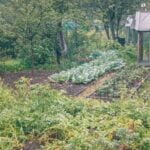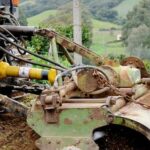Are you a beginner looking to try vegetable gardening in Colorado? Whether you’re a newcomer to the state or new to gardening altogether, this introductory guide will provide you with essential information and tips to help you get started.
From understanding the unique climate and soil conditions in Colorado to selecting the right vegetables and learning best practices for planting and caring for your garden, this article aims to equip you with the knowledge and resources needed to successfully grow your own produce.
Colorado’s diverse climate and soil can present both challenges and opportunities for vegetable gardening. With the right approach, however, it’s possible to cultivate a thriving garden that yields a bountiful harvest.
In this guide, you’ll learn about the specific factors that can affect your gardening efforts in Colorado, as well as essential tools, equipment, and techniques that are crucial for success. By the end of this article, you’ll have a solid understanding of what it takes to start your own vegetable garden in Colorado.
Whether you have limited outdoor space or an expansive backyard, vegetable gardening is a rewarding activity that can provide fresh produce for your meals while also promoting sustainability and self-sufficiency. This guide will cover everything from preparing the soil and selecting suitable vegetables to dealing with common pests and diseases that may affect your garden.
With this knowledge at your fingertips, you’ll be well-equipped to embark on an exciting journey into vegetable gardening in Colorado. So let’s dive in and get started.
Understanding the Climate and Soil in Colorado for Vegetable Gardening
Colorado’s climate and soil present unique challenges and opportunities for beginner vegetable gardeners. Understanding these factors is crucial to successful gardening in the state.
Colorado’s climate varies greatly depending on location, with many areas experiencing a combination of high altitude, intense sunlight, low humidity, and a wide range of temperatures. The state’s soil also varies widely, from clay and sandy soils to more fertile loam in certain areas. It is essential for beginner gardeners to understand how these factors will impact their vegetable garden.
One key consideration when gardening in Colorado is the short growing season due to the risk of late spring frosts and early fall freezes. As a result, selecting vegetables that are well-suited for this climate is crucial. Cold-hardy vegetables such as kale, spinach, carrots, and radishes tend to perform well in Colorado’s cooler temperatures.
In addition to understanding the climate and choosing the right vegetables, beginner gardeners must also consider soil quality. Colorado’s soil can be alkaline and lacking in organic matter. Amending the soil with compost and other organic materials is essential for successful vegetable gardening.
To help guide beginners through these considerations, there are numerous resources available including local gardening clubs, extension services, and online forums dedicated to vegetable gardening in Colorado. Seeking out support from experienced gardeners can provide valuable insights and tips for navigating the unique challenges of vegetable gardening in the state.
| Climate Factors | Vegetable Selection |
|---|---|
| High altitude | Cold-hardy vegetables like kale and spinach |
| Intense sunlight | Carrots and radishes perform well |
Selecting the Right Vegetables for the Colorado Climate
When it comes to vegetable gardening in Colorado, one of the most important factors to consider is the climate. With its semi-arid conditions and significant temperature fluctuations, Colorado presents unique challenges for gardeners. However, with careful planning and selection of the right vegetables, it is possible to have a successful garden in this state.
Understanding the Colorado Climate
Colorado experiences a wide range of climates due to its diverse topography and elevation. In general, the state has cool nights, low humidity, and intense sunlight. These conditions can impact the types of vegetables that will thrive in Colorado gardens. It is important to consider the length of the growing season, as well as the potential for late spring frosts and early fall freezes.
Choosing Suitable Vegetables
When selecting vegetables for your Colorado garden, it is essential to choose varieties that are well-suited to the climate and growing conditions. Some vegetables that tend to do well in Colorado include leafy greens such as kale and spinach, root vegetables like carrots and beets, as well as hearty crops like potatoes and onions. Additionally, certain types of tomatoes, peppers, and squashes can also be successful if given proper care.
Adapting Your Choices
It is important for beginner vegetable gardeners in Colorado to remain flexible with their choices. Experimenting with different varieties and observing how they respond to the unique climatic conditions can help you determine which vegetables are best suited for your specific location within the state. Additionally, taking note of local gardening advice and learning from experienced growers can provide valuable insight into adapting your vegetable choices for success in this challenging environment.
Preparing the Soil and Garden Bed for Planting
One of the most important steps in starting a successful vegetable garden in Colorado is properly preparing the soil and garden bed for planting. Colorado’s unique climate and soil conditions require some special attention to ensure that your vegetables will thrive.
First, it’s essential to test the pH of your soil to determine its acidity or alkalinity. Most vegetables grow best in slightly acidic soil, with a pH level between 6.0 and 7.0. You can purchase a simple at-home soil testing kit or send a sample to a local extension office for analysis. Based on the results, you may need to amend your soil with lime to raise the pH or sulfur to lower it.
Next, consider the composition of your soil. Colorado soils are often sandy or clay-heavy, which can impact water retention and drainage. Adding organic matter such as compost, peat moss, or well-rotted manure can improve the texture and fertility of the soil, providing essential nutrients for your growing vegetables.
Once you’ve addressed the pH and composition of your soil, it’s time to prepare the garden bed for planting. Clear any debris or weeds from the area and loosen the soil to a depth of at least 12 inches.
It’s also beneficial to create raised beds if drainage is a concern in your area. Raised beds not only improve drainage but also warm up more quickly in Colorado’s cooler spring temperatures, extending the growing season for your vegetable garden.
| Soil Preparation Step | Details |
|---|---|
| Soil pH Testing | Determine acidity/alkalinity level; adjust with lime or sulfur as needed |
| Add Organic Matter | Improve texture and fertility with compost, peat moss, or manure |
| Garden Bed Preparation | Clear debris, loosen soil, consider raised beds for improved drainage |
By following these steps for preparing the soil and garden bed for planting, beginner vegetable gardeners in Colorado can set their gardens up for success from the very beginning. Taking these measures will create an optimal growing environment for a bountiful harvest of fresh, healthy vegetables throughout the growing season in Colorado’s challenging climate.
Essential Tools and Equipment for Vegetable Gardening in Colorado
When starting a vegetable garden in Colorado, having the right tools and equipment is crucial to ensure that your garden thrives in the unique climate and soil. Here are some essential tools and equipment that every beginner vegetable gardener in Colorado should have:
Quality Hand Tools
Investing in high-quality hand tools such as a trowel, hand fork, pruning shears, and a hand weeder is important for maintaining your vegetable garden. These tools will help you with tasks such as planting, weeding, pruning, and harvesting your vegetables.
Garden Hoe
With Colorado’s dry climate and often compacted soils, having a sturdy garden hoe is essential for breaking up the soil and removing weeds. Look for a hoe with a sharp blade that can easily cut through tough roots and weeds.
Irrigation System
In Colorado’s arid climate, it’s important to have an efficient irrigation system to ensure that your vegetables receive enough water. Consider investing in soaker hoses or drip irrigation systems to deliver water directly to the plant roots while minimizing evaporation.
Protective Gear
Colorado’s unpredictable weather can sometimes bring hail storms or sudden drops in temperature. To protect your vegetables from these weather events, invest in row covers or frost blankets that can be easily draped over your plants when needed.
By having these essential tools and equipment on hand, you’ll be well-prepared to start your vegetable gardening journey in Colorado. With the right tools at your disposal, you’ll be better equipped to tackle the unique challenges of gardening in this beautiful state.
Best Practices for Planting and Caring for Vegetables in Colorado
When it comes to vegetable gardening in Colorado for beginners, there are certain best practices that can help ensure a successful and bountiful harvest. Colorado’s unique climate and soil conditions require careful planning and attention to detail in order to grow healthy vegetables.
One of the most important best practices for planting and caring for vegetables in Colorado is to pay close attention to the local climate and its challenges. With its high altitude, intense sunlight, and fluctuating temperatures, Colorado presents some unique obstacles for vegetable gardening.
Another best practice for vegetable gardening in Colorado is to choose the right varieties of vegetables that are well-suited to the state’s climate. Certain vegetables, such as tomatoes, peppers, and squash, thrive in Colorado’s warm summers, while others like lettuce, spinach, and kale do better in the cooler temperatures of spring and fall. It’s also important to consider factors such as water requirements and frost tolerance when selecting which vegetables to plant.
In addition to choosing the right vegetables, it’s crucial to properly prepare the soil and garden bed for planting. Colorado’s soil tends to be alkaline with low organic matter content, so amending the soil with compost or other organic matter can greatly improve its fertility and structure.
Proper spacing, mulching, watering techniques, and fertilization are all key components of caring for a vegetable garden in Colorado. By following these best practices, beginner gardeners can set themselves up for success in their endeavor to grow their own fresh produce in this challenging but rewarding environment.
Dealing With Common Pests and Diseases in Colorado Vegetable Gardens
When it comes to vegetable gardening in Colorado for beginners, one of the biggest challenges is dealing with common pests and diseases that can affect your garden. It’s important to be aware of these issues and have a plan in place to prevent and address them.
Some common pests that you may encounter in Colorado include aphids, cutworms, and flea beetles. These pests can cause damage to your vegetables, so it’s essential to monitor your garden regularly and take action at the first sign of infestation. One effective way to control pests is by using natural predators such as ladybugs or predatory insects like lacewings.
In addition to pests, Colorado gardeners also need to be mindful of diseases that can impact their vegetable crops. Powdery mildew, blight, and root rot are some common diseases that can affect plants in this region. To prevent these issues, it’s crucial to practice good garden hygiene by avoiding overwatering and providing adequate air circulation between plants.
To help you further in preventing and dealing with common pests and diseases in your Colorado vegetable garden, here are some tips:
- Regularly inspect your plants for signs of pest infestation or disease
- Use row covers or netting to protect plants from pests
- Practice crop rotation to minimize the risk of disease buildup in the soil
- Utilize organic pest control methods such as neem oil or insecticidal soap
- Keep garden beds clean and free from debris that could harbor pests or disease-causing organisms
By being proactive and taking steps to prevent and address common pests and diseases, you can increase the chances of a successful harvest from your Colorado vegetable garden. Additionally, seeking advice from local gardening resources or joining a community gardening group can provide valuable support for navigating these challenges.
Harvesting and Preserving Your Vegetable Garden’s Bounty
Once your vegetable garden in Colorado has yielded a bountiful harvest, it’s important to know how to properly harvest, store, and preserve your vegetables to ensure that you can enjoy them for months to come. Here are some essential tips for harvesting and preserving your vegetable garden’s bounty:
1. Harvesting: When it comes to harvesting your vegetables, timing is crucial. You want to pick your vegetables at the peak of ripeness for the best flavor and nutritional value. Be sure to use a sharp knife or scissors to avoid damaging the plant, and handle the vegetables gently to prevent bruising.
2. Storing: After harvesting, it’s important to store your vegetables properly to prolong their shelf life. Some vegetables, like carrots and beets, can be stored in a cool, dark place for several months. Others, like tomatoes and peppers, are best enjoyed fresh but can also be preserved through canning or freezing.
3. Preserving: There are several methods for preserving your vegetable harvest, including canning, pickling, fermenting, and freezing. Canning is a popular method that allows you to store fruits and vegetables in jars at room temperature for long periods of time. Pickling is another great way to preserve vegetables like cucumbers, beans, and peppers in a flavorful brine. Freezing is ideal for preserving many types of vegetables without compromising their taste or texture.
By following these guidelines for harvesting and preserving your vegetable garden’s bounty in Colorado, you can savor the delicious flavors of your homegrown produce throughout the year.
Remember that proper preservation techniques are imperative after all the hard work you have dedicated into planting and growing them.
Resources and Support for Beginner Vegetable Gardeners in Colorado
As a beginner in vegetable gardening in Colorado, it can be overwhelming to navigate the unique challenges that come with the state’s climate and soil. Fortunately, there are numerous resources and support systems available to help you on your gardening journey.
One of the best places to start is with local gardening clubs and organizations. These groups often have experienced members who can provide valuable advice, as well as access to community gardens where you can learn hands-on skills.
Another valuable resource for beginner vegetable gardeners in Colorado is the local extension office. The Colorado State University Extension provides a wealth of information on topics such as soil health, plant selection, pest management, and more. They also offer workshops and classes specifically tailored to the needs of Colorado gardeners.
Additionally, online forums and social media groups can be a great source of support for beginner vegetable gardeners in Colorado. Connecting with other local gardeners can provide insight into what works best in the unique climate and growing conditions of the state. It’s also a great way to find encouragement and troubleshooting tips when facing challenges in your own garden.
By tapping into these resources and support systems, beginner vegetable gardeners in Colorado can gain the knowledge and confidence needed to successfully grow their own bountiful harvests. Whether it’s learning from experienced gardeners, accessing information from extension offices, or connecting with peers online, there are plenty of opportunities to get guidance and support along the way.
Conclusion and Next Steps in Your Colorado Vegetable Gardening Journey
In conclusion, vegetable gardening in Colorado for beginners can be both rewarding and challenging. By understanding the unique climate and soil of the region, selecting the right vegetables, and following best practices for planting and care, you can enjoy a bountiful harvest from your garden. It’s important to be prepared for common pests and diseases that may affect your plants, and to take steps to preserve your harvest for future enjoyment.
As you continue on your Colorado vegetable gardening journey, it’s essential to seek out resources and support to help you along the way. Joining a local gardening club or online community can provide valuable advice and guidance from experienced gardeners who understand the specific challenges of growing vegetables in Colorado. Additionally, attending workshops or classes on vegetable gardening in your area can further expand your knowledge and skills.
Ultimately, the next steps in your Colorado vegetable gardening journey involve putting into practice what you’ve learned and staying open to continued learning and improvement. With dedication and patience, you can cultivate a thriving vegetable garden that will provide fresh, nutritious produce for you and your family while also connecting with nature and enjoying the healthy benefits of outdoor activity. Happy gardening.
Frequently Asked Questions
What Is the Easiest Vegetable Garden for Beginners?
The easiest vegetable garden for beginners is typically one that includes low-maintenance plants such as tomatoes, peppers, and beans. These vegetables require minimal care and are great for those new to gardening.
What Vegetables Are Easiest to Grow for Beginners?
Vegetables that are easiest to grow for beginners include lettuce, radishes, and green beans. These plants have a relatively short growing season and are fairly simple to cultivate, making them ideal for novice gardeners.
When Should I Start Planting My Garden in Colorado?
In Colorado, the best time to start planting your garden is typically in late April or early May. This allows you to take advantage of the warmer weather while minimizing the risk of any late spring frost damaging your plants.

If you’re looking to get into vegetable gardening, or are just looking for some tips on how to make your current garden better, then you’ve come to the right place! My name is Ethel and I have been gardening for years. In this blog, I’m going to share with you some of my best tips on how to create a successful vegetable garden.





